When looking at the aggressive, almost military police response to unrest in Ferguson, Missouri, a big dose of collective amnesia makes it easy to forget that the United States has been here before. And may yet be there again.
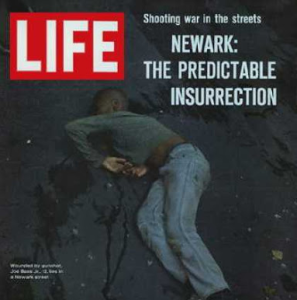
Collective amnesia about past eruptions of racial conflict has left Americans with a false sense that what happened in Ferguson is somehow new. But the only thing new is the technology. The attitudes on display are sadly familiar.
Forty-seven years ago, the African-American population of New Jersey’s largest city took to the streets after a violent encounter between white police officers and an unarmed black man. While the body count in Newark—26 people dead and 1,500 injured—was far greater than in the recent disturbances in Ferguson, Missouri, the parallels between the two tragedies are too clear to be ignored.
After the terrible events of July 1967, New Jersey Governor Richard Hughes was faced with the same formidable challenge that Missouri Governor Jay Nixon faces now: How to avert future eruptions along the racial fault line that has undermined the American experiment in democracy since before the nation was founded.
“Newark and Ferguson are absolutely linked,” says Paul McLemore, a front-line witness to the five days of rage that shook not just Newark and New Jersey but the entire nation. McLemore, the first African-American to become a New Jersey State trooper, was the only black trooper in Newark during what the media of the day called “the riots.” He later became a civil rights attorney and recently retired as a municipal court judge. Looking back at Newark through the lens of Ferguson, he told WhoWhatWhy: “Very little has changed between the police and the community over all these years. We still have a very deep divide along racial lines.”
***
The parallels are numerous:
In both Newark and Ferguson, a mostly African-American population was policed by an overwhelmingly white police force that reported to a white political power structure.
In both communities African-American families were struggling economically. Neighborhood tensions were exacerbated by a sky-high youth unemployment rate.
In both places the powers-that-be made a last-minute effort to promote a black man from within the ranks of law enforcement in hopes of placating a distrustful black population.
And in both Newark and Ferguson an aggressive response by the authorities to an initial incident triggered the prolonged period of civil unrest.
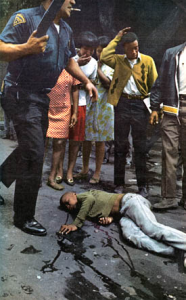
Racial tensions had been percolating in Newark for months before the summer of 1967. As the national civil rights movement gained momentum, the city’s black community was becoming more assertive. Heavy-handed land use decisions by the white municipal power structure, such as the decision to locate a new medical school in the heart of the black community, displacing long-time residents, generated organized push-back. African-Americans felt they were being taken for granted by the white politicians they had supported for a generation and had little tangible to show for their loyalty.
***
On July 12, 1967, police pulled over John W. Smith, an African-American cab driver, for what started out as an alleged traffic violation. Police contend Smith cursed at them when they encountered him and that when the police went to take Smith into custody he assaulted them. According to the police, they got Smith into their squad car but when they got to the precinct they maintain Smith continued to resist. This time, passersby who witnessed the altercation heckled the police, demanding that they take the handcuffs off Smith.
Large crowds formed outside the precinct house where Smith was held. Community leaders demanded to see him and when they were granted access, they discovered he needed immediate medical attention. Smith was sent to the hospital for treatment for a skull injury and broken ribs. By 7 p.m. the next day, Smith was released to his lawyer but the damage was done. Word on the street was that Smith had been fatally beaten.
Over the next 24 hours, the Newark Police Department tried to keep a lid on a very dynamic situation. Cab drivers were mobilized to protest the treatment of their colleague, community members were protesting police brutality, and street conditions were deteriorating. Police were being pelted by debris and looting started to break out.
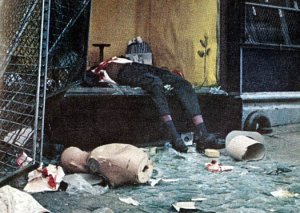
It wasn’t until 2:20 a.m. on the third day that Newark Mayor Hugh Addonizio called Governor Hughes to ask for the State Police and National Guard to be deployed to his city.
McLemore was ordered to report to the New Jersey State Police barracks at Hightstown in his riot gear. According to media accounts, fires were burning out of control in the central city. He joined a caravan of state police cars with hundreds of trooper heading up the New Jersey Turnpike, lights flashing. “The guys with me were just ecstatic, like they were going off to war,” McClemore says of the white troopers he rode with. “We got to where the Newark airport is. You could see Newark’s skyline and all you could see was smoke and flames. I thought `Lord, what is going to happen here?’”
“When we drove through the central district of Newark things had gotten so bad——Newark police community relations had deteriorated so much, people were out on their porches applauding us. `Hooray! The troops have arrived. Everything will be fine. They will restore order.’ Black folks were welcoming the troops in.”
This welcoming attitude did not last long. Within days, Governor Hughes ordered the National Guard and the New Jersey State Police out of Newark. “When we left there,” McLemore says, “we were like a dog with its tail between its legs. People threw piss at us.”
What accounted for the New Jersey State Police and the National Guard’s precipitous fall from community grace?
The Lilley Report
The tragic details are laid out in an official account compiled by “The Governor’s Select Commission on Civil Disorder.” This document, known as the Lilley Report after its chairman, then AT&T President Robert D. Lilley, has slipped into undeserved obscurity.
In fact, the Lilley Report can serve as a model for anyone hoping to understand the troubles in Ferguson and other racially divided communities.
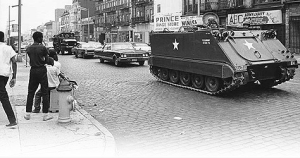
In August of 1967, a month after Newark burned, Governor Hughes convened a blue-ribbon panel of religious, political, and legal leaders and charged them with generating “a realistic analysis of the disorders….and practical proposals” to help prevent a recurrence of the unrest.
“They were not a bunch of bleeding-heart liberals,” says McLemore. “They came out with a very strong indictment of how the State Police and National Guard actually made a bad situation worse.”
***
Over months of investigation, the panel took sworn testimony from more than 100 witnesses ranging from the Superintendent of the New Jersey State Police to Amiri Baraka, a poet and playwright whose activism had made him a frequent target for the local police. The Commission also heard from John W. Smith, whose arrest was the flashpoint for events that would haunt Newark for decades.
After speaking with scores of Newark store owners and residents, the Commission concluded that members of both the police and the National Guard, motivated by racial prejudice, had used “excessive and unjustified force” on Newark residents, and had specifically targeted African-American-owned businesses for destruction. “These raids resulted in personal suffering to innocent small businessmen and property owners who have a stake in law and order and who had not participated in any unlawful act. It embittered the Negro community as a whole when the disorders had begun to ebb,” concluded the Commission.
Perhaps the most volatile issue raised by the breakdown of order in Newark was that of sniper fire.
Phantom Snipers
During the days of unrest law enforcement and the National Guard claimed that they were fired on by snipers, whose shots led to the deaths of a Newark police detective and a Fire Captain responding to a fire call. While not outright rejecting this claim, the Lilley Report noted the doubts of Newark’s own Police Director at the time, Dominick Spina: “A lot of the reports of snipers was due to the, I hate to use the word, trigger-happy Guardsmen, who were firing at noises and firing indiscriminately, it appeared to me, and I was out in the field at all times.”
McLemore’s own experience shows how indiscriminate shooting by the police and National Guard resulted in dangerous “friendly fire” exchanges. He recalls walking in a patrol formation at dusk when a street light came on and a Newark cop on patrol with him reflexively shot it out, prompting another patrol to blindly return fire in his direction. “It was the Keystone Cops. You had a situation where the National Guard and police were shooting at each other.”
Out of the 26 fatalities during the five days of unrest, 23 (including a number of innocent bystanders) were from gunshot wounds. The Lilley report estimated that the National Guard and N.J. State police fired some 13,000 rounds in all. No total was available for the local police, who reported killing people, seven “justifiably” and three “by accident.”
***
What makes the Lilley Report required reading today is not just its detailed summary of what happened during the five days of civil unrest in Newark. Like the Kerner Commission, which then-President Lyndon Johnson created to look into the issue of urban unrest on a national scale, the Governor’s Select Commission took pains to place the 1967 disturbances in historical perspective.
The 200-page Lilley Report cast a critical eye on the City of Newark’s economic and political power structure. It identified a widening gap between the white-dominated municipal government and the overwhelmingly black electorate the city’s leaders were supposed to serve. It documented how African-American businesses and local contractors were systematically excluded from public contracts, and it characterized the pervasive corruption of Newark’s officialdom by quoting the words of one informant: “There is a price on everything in City Hall.”
Among the statistics the report laid out to describe Newark’s endemic poverty: the city had the highest maternal and infant mortality rate in the nation and the highest rate of tuberculosis infection, and it ranked ninth out of 302 American cities in severity of air pollution.
If further confirmation of the Lilley Report’s jaundiced view of Newark’s elected leadership were needed, not long after the report was released the city’s Mayor Hugh Addonizio was indicted and convicted on multiple corruption charges at a trial that linked him to organized crime.
Ignoring History
In contrast to the thoughtful, judicious Lilley Report, post-Ferguson analysis has so far failed to dig much deeper than perceived flaws in police tactics Legal scholar Gloria J. Browne-Marshall, a professor at John Jay College, says the current level of discourse around the issues raised by Ferguson is sadly diminished by the media’s short attention span. “You can’t get into a deeper conversation about race and the law with four people sharing a three-minute panel format.”
Rutgers Professor Clement Price, Newark’s official historian and one of the nation’s foremost authorities on black history, is more blunt. The analysis requires looking at St. Louis and white flight from an anthropological perspective, he said.
For Price, a common thread of enduring discrimination and resulting alienation from the political system links the Newark of 1967 and the Ferguson of 2014: “They’re predominately black towns but you would not know it from walking into City Hall, the Police Station or the Fire Department.”
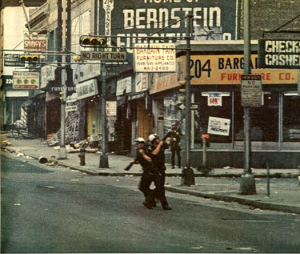
Even today, in both Newark and Ferguson, African-American homeowners are in the midst of a foreclosure crisis that continues to undermine their neighborhoods. While economists proclaim the end of the Great Recession, 54 percent of mortgages in Newark are underwater, with the homeowner owing the bank more than the property is worth. In Ferguson, nearly half the households are underwater.
And yet the fate of the original Lilley Report, and of President Johnson’s Kerner Commission, shows that investigations by themselves can have no effect without the political will to act on their findings.
Two Societies
In 1968 the Kerner Commission warned the country that “our nation” was “moving toward two societies, one black, one white—-separate and unequal.” The Commission placed much of the blame for urban unrest on systemic white racism. It called for a massive Marshall Plan-like approach to improve economic conditions in African-American communities.
Dr. Martin Luther King hailed the Kerner report as a “physician’s warning of approaching death, with a prescription for life.” But the report failed to gain traction with President Johnson, who was wholly pre-occupied with the Vietnam War. In April of 1968, after King’s assassination, rioting broke out in over 100 American cities. Yet Johnson still rejected the Kerner Commission’s recommendations. And of course, the Lilley Report failed to get the attention it merited.
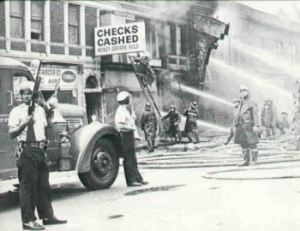
The bizarre images of Ferguson police confronting civil disobedience with Army surplus heavy weaponry may have no direct historical antecedents. But focusing on what is superficially unique, as all too many reporters do, creates a kind of a Narcissism of Now that cuts us off from the lessons of our own history.
Today, tanks and automatic rifles; yesterday, police dogs and fire hoses.
Yes, we have been here before, and with a much higher body count. And we will be here again unless we stop pretending that the racial divide in Obama’s America is a thing of the past.


